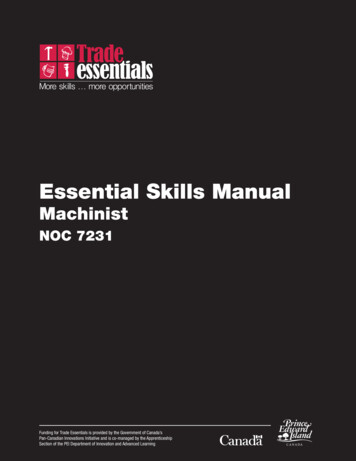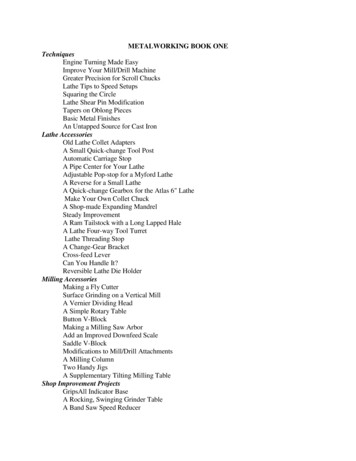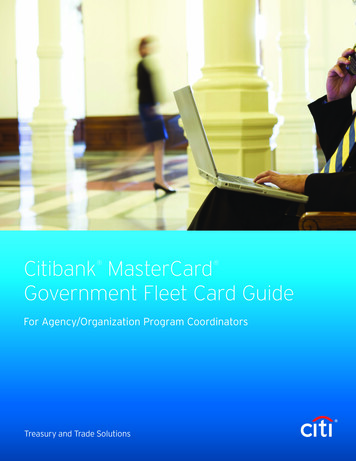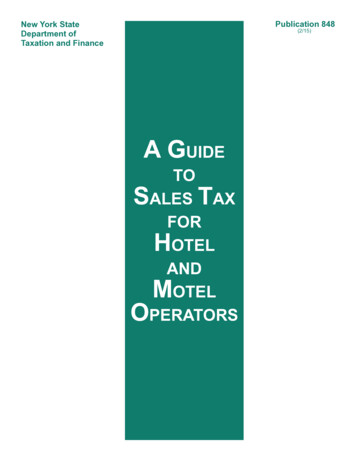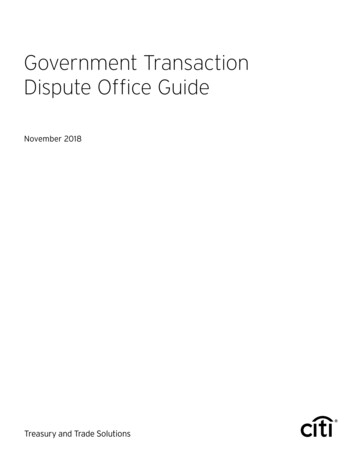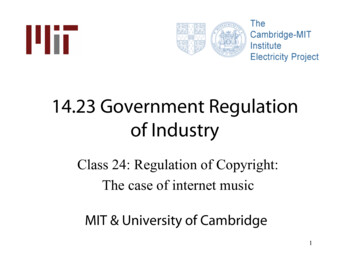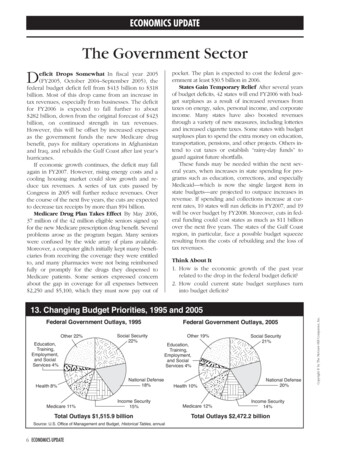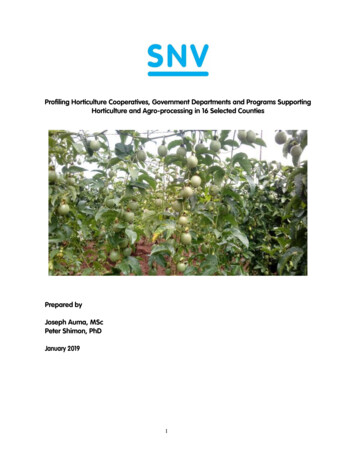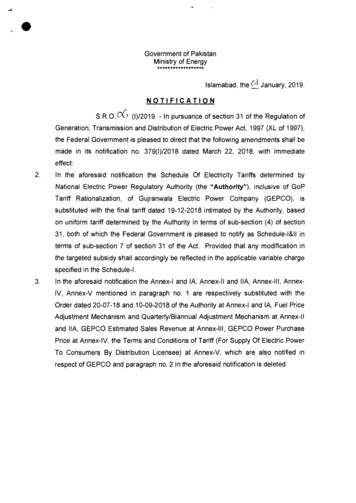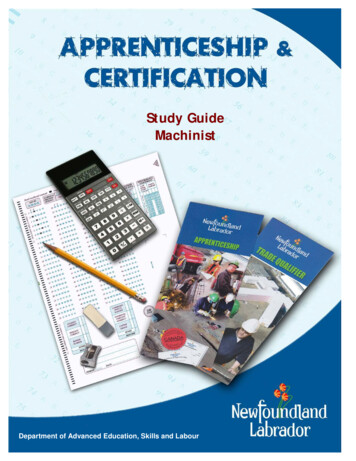
Transcription
Study GuideMachinistDepartment of Advanced Education, Skills and Labour
Apprenticeship and CertificationStudy GuideMachinist(Based on 2013 NOA)Government of Newfoundland and LabradorDepartment of Advanced Education, Skills and LabourApprenticeship and Trades Certification DivisionVersion 6March 2019
Table of ContentsIntroduction . 3Exam Process . 4Before the Exam. 4During the Exam. 4After the Exam . 4Exam Format . 5Exam Content . 9Understanding the National Occupational Analysis (NOA) . 9Exam Breakdown . 11NOA Sub-tasks. 12Task Profile Checklist . 13Create a Study Plan . 19Resources - Websites . 22Resources – Book List. 23Conclusion . 24AppendicesAppendix A:Regional Offices . 25Appendix B:Calculator Use . 26Appendix C:Answer Sheet Example . 27
IntroductionThis Study Guide has been developed by the Newfoundland and Labrador Department ofAdvanced Education, Skills and Labour, Apprenticeship and Trades Certification Division, toassist apprentices and trade qualifiers as they prepare to write the Interprovincial (IP) Red SealExam. IP Exams are available for all Red Seal trades. For a list of Interprovincial trades pleaserefer to the Department of Advanced Education, Skills and Labour Some of the specific goals of this guide are: to help you understand the skills and knowledge that might be covered on the exam to help you identify your strengths and weaknesses to provide organization and structure for a course of study to provide a list of resources to help you with your study plan to support and supplement the teaching and learning processThis study guide outlines the theoretical portion of the program. The intent is not to replacetechnical training provided under the guidance of instructors. Rather, it is a tool to be used inconjunction with formal training.Study Guide Machinist 20193
Exam ProcessBefore the ExamYou must contact the nearest Apprenticeship and Trades Certification Divisional office to makerequest to write the IP Red Seal exam (See Appendix A for a list of regional offices). Uponapproval, the Apprenticeship Program Officer (APO) will notify you of your eligibility to writethe exam, and provide you with scheduling information. If you require special accommodationsdue to a disability or language barrier, please contact your regional office for information onapplying for this service.During the ExamYou must bring: personal identification such as a photo or signature ID or valid Newfoundlandand Labrador driver’s license your notification letterThe following will be provided: a calculator (see Appendix B for calculator information) all other items required such as pencils, scrap paper, etc.Important Note:Personal cell phones, calculators, or other electronic equipment are NOT allowed into theexam room. If you do bring them, they will be stored away and returned to you when youhave completed the exam.After the ExamResults will be mailed to you approximately seven to ten days after completion of the exam. Allnecessary instructions and information will be provided in the results letter.The percentage mark you obtained will be provided. You will also be given a section by sectionbreakdown, showing how many questions were in each section, as well as the number ofquestions in each section you completed successfully.If you are successful in obtaining a 70% or more on your exam, you will be issued aNewfoundland and Labrador Certificate of Qualification with a Red Seal endorsement.4Study Guide Machinist 2019
Exam FormatAll IP Red Seal exams are written in multiple-choice format. Each exam has between 100 and150 questions. A multiple choice question consists of a stem (a complete question) followed byfour options (A, B, C, D). The stem contains all the information necessary to answer thequestion. The options consist of the one correct answer and three “distracters.” Distractersare incorrect. (See Appendix C for a sample answer sheet).IP Red Seal exams contain three types of questions:Level 1Knowledge and RecallLevel 2Procedural and ApplicationLevel 3Critical ThinkingQuestions at this level test your ability to recall and understand definitions, facts,and principles.Questions at this level test your ability to apply your knowledge of procedures toa new situation.Questions at this level test your ability to interpret data, solve problems andarrive at valid conclusions.On the following pages, examples of each of the three types of questions are provided.Level 1 Examples:1. Which type of hole requires a spiral-fluted hand Keyed or slotted.Study Guide Machinist 20195
2. Why is a grinding allowance left on the workpiece prior to heat treatmentprocess?A.B.C.D.Material shrinkage.Material hardening.Material distortion.Material expansion.3. What product is used to check the final fit of mating tapers?A.B.C.D.Layout dye.Prussian blue.Penetrating dye.Lapping compound.Level 2 Examples:1. What size is the gauge block build-up used with a 5 in. sine bar to set thework piece at an angle of 4 , 30’?A.B.C.D.60.1961 in.0.3923 in.0.4537 in.0.7846 in.Study Guide Machinist 2019
2. Which offset is required to produce an eccentric with a throw of 0.400 in.?A.B.C.D.0.100 in.0.200 in.0.300 in.0.400 in.3. Which instruments are used to measure a 1 in. diameter bored hole with atolerance of 0.001 in.?A.B.C.D.Centre gauge and gauge blocks.Dial indicator and gauge blocks.Spring-joint dividers and micrometer.Telescopic gauge and micrometer.Level 3 Examples:1. What is the time required to turn SAE 4140 steel to 2 in. diameter down to1.875 in. diameter with a depth of cut at 0.0625 in., 9 in. in length, using acutting speed of 70 sfpm, with a feed rate of 0.006 in. per revolution?[rpm (12 x CS) (p ? x D)A.B.C.D.11 minutes, 13 seconds.12 minutes, 31 seconds.14 minutes, 30 seconds.15 minutes, 37 seconds.Study Guide Machinist 20197
2. How far is the centerline of the spindle from the edge of the workpiecewhen using a 0.200 in. diameter edge finder?A.B.C.D.0.100 in.0.200 in.0.300 in.0.400 in.3. Which type of grinding machine is used to produce 1000 dowel pins thatmeasure 0.250 in. rtical.Source of 4ns-eng.html?tid 1398Study Guide Machinist 2019
Exam ContentUnderstanding the National Occupational Analysis (NOA)The NOA is a document used for Red Seal trades that describes the knowledge, skills andabilities required by a fully competent tradesperson working in that trade. The content for theIP Red Seal exam is based on the NOA. The NOA is an excellent tool to use as you study for theRed Seal exam. NOAs can be found at www.red-seal.ca.NOA material is organized into major content areas called BLOCKS. The blocks are furtherbroken down into TASKS and SUB-TASKS.NOAStudy Guide Machinist 2019BlocksBlocks Tasks Sub-tasks9
NOA Pie ChartThe NOA Pie Chart presents the block percentages in the form of a pie chart which tells you theapproximate number of questions from each block. For example, 9% of the questions on theMachinist Exam will be based on Block A.MACHINISTH13%G8%A9%B9%F6%C8%D23%E24%Block TitlesBlock ACommon Occupational SkillsBlock EConventional Milling MachinesBlock BBench WorkBlock FPower SawsBlock CDrill PressesBlock GPrecision Grinding MachinesBlock HComputer Numerical Control (CNC)Machine-ToolsBlock D Conventional Lathes10Study Guide Machinist 2019
Exam BreakdownThe Machinist IP Red Seal Exam has 135 questions. The following table shows a breakdown ofthe approximate number of questions that come from each NOA block. It is important to notethat the number of questions can change at any time. When you are ready to write your exam,you may contact your regional office to verify the number of questions (See Appendix A).# of QuestionsBlock ATask 1Task 2Task 3Block BCommon Occupational SkillsOrganizes workProcesses workpiece materialMaintains machines and toolingBench WorkTask 4Task 5Block CTask 6Task 7Block DTask 8Task 9Block ETask 10Task 11Block FTask 12Task 13Block GTask 14Task 15Block HTask 16Task 17Task 18Performs hand processesRefurbishes componentsDrill PressesSets up drill pressesOperates drill pressesConventional LathesSets up conventional lathesOperates conventional lathesConventional Milling MachinesSets up conventional milling machinesOperates conventional milling machinesPower SawsSets up power sawsOperates power sawsPrecision Grinding MachinesSets up precision grinding machinesOperates precision grinding machinesComputer Numerical Control (CNC) Machine-ToolsPerforms basic CNC programmingSets up CNC machine-toolsOperates CNC machine-toolsTotalStudy Guide Machinist 201913121131318121713511
NOA Sub-tasksThe following NOA Task Profile Checklist outlines the blocks, tasks and sub-tasks for your trade.The IP Red Seal exam is written to test your knowledge and abilities regarding the sub-tasks inthe NOA. This chart can be used to review your current knowledge. You can review by placinga checkmark ( ) next to those you understand fully.Place your focus on those you do not understand and study them until you are comfortablewith the material. Think of possible questions in that particular content area.The NOA also contains a list of “supporting knowledge and abilities” for each sub-task. Theyare the skills and knowledge you must have to perform a sub-task. The supporting knowledgeand abilities identified under each sub-task will be very helpful as you review. The list can befound in the NOA for your trade.12Study Guide Machinist 2019
Task Profile ChecklistBased on 2013 NOAMachinistBlock A: Common Occupational Skills Task 1: Organizes WorkSub-Tasks Interprets documentation Plans sequence of operations Maintains safe work environment Uses personal protective equipment (PPE) and safety equipment Uses hoisting, lifting and rigging equipment Task 2: Processes Workpiece Material Selects workpiece materialSub-Tasks Performs layout Marks workpiece for identification Performs basic heat treatment Tests workpiece materials Deburrs workpiece Sketches parts Task 3: Maintains Machines and Tooling Cleans machinesSub-Tasks Lubricates machines Sharpens tooling Applies cutting fluids and coolants Trouble-shoots equipment Maintains machine alignment Maintains inspection equipmentStudy Guide Machinist 201913
Block B: Bench Work Task 4: Performs Hand Processes Files workpiece Saws workpieceSub-Tasks Performs hole-making operations Performs threading operations Installs thread inserts Broaches workpiece Performs pressing operations Bends workpiece Finishes workpieceSub-Tasks Task 5: Refurbishes Components Disassembles components Analyzes components Assembles componentsBlock C: Drill PressesSub-Tasks Task 6: Sets Up Drill Presses Selects drill press types Plans drill press sequence Selects drill press speeds and feeds Sets up jigs, fixtures and work holding devices for drill presses Sets up tooling for drill pressesSub-Tasks Task 7: Operates Drill Presses14 Drills holes using a drill pressCuts countersinks, counterbores, chamfers and spot faces using a drill pressPerforms tapping using a drill pressFinishes holes using a drill pressStudy Guide Machinist 2019
Block D: Conventional LathesSub-Tasks Task 8: Sets Up Conventional Lathes Selects conventional lathe typesPlans sequence of operations for conventional lathesSets up work holding devices for conventional lathesSets up tooling for conventional lathesSets up conventional lathe accessoriesSets up workpiece on conventional latheSelects conventional lathe speeds and feedsSets up eccentrics on conventional lathesSub-Tasks Task 9: Operates Conventional Lathes Turns external surfaces using a conventional latheBores holes using a conventional latheFaces surfaces using a conventional latheTurns t
Study Guide_Machinist_2019 3 Introduction This Study Guide has been developed by the Newfoundland and Labrador Department of Advanced Education, Skills and Labour, Apprenticeship and Trades Certification Division, to assist apprentices and trade qualifiers as they prepare to write the Interprovincial (IP) Red Seal Exam. IP Exams are available .
